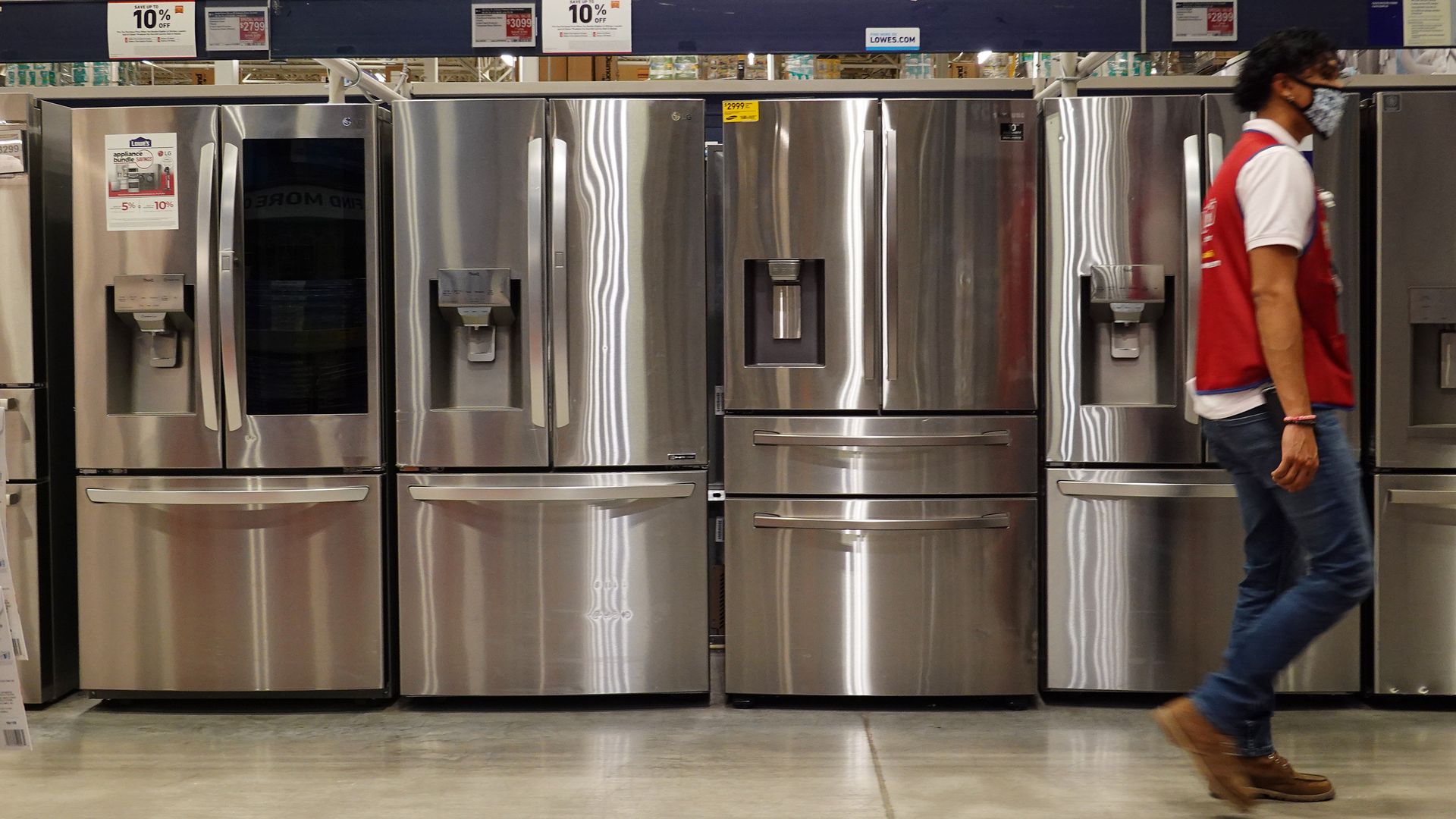| | | | | | | Presented By Deloitte | | | | Axios What's Next | | By Joann Muller, Erica Pandey and Jennifer A. Kingson ·Feb 25, 2022 | | Good morning! Our newsroom continues to follow the Ukraine-Russia crisis. Check out our round-the-clock coverage here. First up today: Why America's youngest workers are already contemplating their next move — and what companies need to do to keep them. - Find something new that speaks to the way we'll live, work, play and get around in the days ahead? Email us at whatsnext@axios.com.
Today's Smart Brevity count: 1,131 words ... 4 minutes. | | | | | | 1 big thing: The Great Resignation generation |  | | | Illustration: Shoshana Gordon/Axios | | | | America's youngest generation entered the job market amid the Great Resignation — and that has changed the way they view working, Erica Pandey writes. Why it matters: This cohort will make up a third of U.S. labor by 2030, shaping the future of work. What's happening: In the spirit of the Great Resignation, Gen Z is far likelier than older generations to job-hop, Karin Kimbrough, chief economist at LinkedIn, told me Thursday during an Axios event. - Gen Z is changing jobs at a rate 134% higher than they were in 2019. Millennials are switching 24% more, and boomers 4% less, per LinkedIn data.
- And they plan to keep job-hopping: Some 25% of Gen Zers say they hope or plan to leave their employers within the next six months, LinkedIn found. Compare that with 23% of millennials, 18% of Gen X, and just 12% of boomers.
"That's a little bit normal because they're younger, and their tenure is shorter," says Kimbrough. - But Gen Z's willingness to hop jobs is remarkable beyond that, she notes. A whopping 75% of Gen Zers say they're willing to switch career paths entirely and look for jobs in new industries. Less than half of those older say the same.
The big picture: Gen Z joined the workforce in the middle of pandemic-induced telework, which has also shaped their view of the working world. - They're 77% more likely to engage with a job posting on LinkedIn that mentions "flexibility" than one that doesn't. Millennials are 30% more likely to click on the posting with "flexibility."
What to watch: For teleworking Gen Zers, many of whom accepted job offers and on-boarded at new companies without meeting any colleagues, workplace culture and company purpose have become increasingly important. - "I think the good news about this new workforce is that a lot of them really resonate as consumers with brands that have a purpose that aligns with their values," Marissa Andrada, Chipotle's chief people officer, told me at the Axios event.
- "The employers need to think about how they create ... mentorship and connection that will really keep Gen Zs in place," Kimbrough says. "Because they are likely to move around."
|     | | | | | | 2. Postal Service defies Biden's climate plan |  | | | The Postal Service's next-generation delivery vehicle. Photo: Courtesy of Oshkosh Defense | | | | President Biden's plan to electrify the federal vehicle fleet by 2035 is off to an inauspicious start, with a deal this week by the U.S. Postal Service to buy nearly 150,000 gasoline-powered mail trucks, writes Joann Muller. Why it matters: The $11.3 billion contract commits the Postal Service to at least another decade without electrifying their fleet, undercutting the nation's climate goals, say Biden administration officials and environmental groups, which tried to block it. Details: The contract with OshKosh Defense is for up to 165,000 vehicles over the next decade, 90% of which would be conventional gasoline-powered trucks. - Oshkosh says the trucks were designed so that it can produce any mix of electric or gas vehicles USPS wants, including an all-electric fleet.
Yes, but: Opponents say the USPS used a flawed environmental analysis that downplayed the benefits and overestimated the costs of going electric. - The Postal Service projected gas prices of $2.19 per gallon, rising to $2.55 by 2040, for example. But gas prices were already above $2.80 a gallon when it did the analysis, the EPA said.
- And with energy prices soaring in light of the new Russia-Ukraine conflict, it's hard to see gas prices falling any time soon.
The other side: Postmaster General and USPS CEO Louis DeJoy says the agency's decision was "fiscally responsible" and that postal workers couldn't wait any longer for safer, modern vehicles. - As the Postal Service's finances improve, it will consider EVs — if Congress provides additional funding, he said.
What to watch: A legal battle could be next, along with intense scrutiny from Congress. At least your mail carrier should be happy: The new postal trucks are chock full of new safety and convenience features. Read the full story |     | | | | | | 3. Cashierless tech comes to Whole Foods |  | | | Bring a QR code or your palm. Photo: Noam Galai/Getty Images | | | | The first Whole Foods equipped with cashierless technology from Amazon opened this week in Washington, D.C., allowing customers to avoid the register, Hope King writes. Why it matters: The 21,500-square-foot store demonstrates how much autonomous shopping has improved. - Amazon, the grocer's parent company, has been experimenting and expanding its "Just Walk Out" system since at least 2016.
- Smaller versions of its cashierless stores, Amazon Go, are about 1,200 and 2,300 square feet, and the company opened a 25,000-square-foot version last year under its Amazon Fresh brand.
Details: The new Whole Foods in Washington uses cameras, sensors and software similar to self-driving cars to track people and products throughout the store. - Shoppers who want to skip going through a checkout process of any kind can scan a QR code from their Amazon or Whole Foods app, their palm or an Amazon-linked credit or debit card when they walk in, before they start putting groceries into their baskets.
- Shoppers can still use self-checkout lanes, where cash, gift cards and supplemental nutrition program benefits are accepted.
- Amazon says "a comparable number" of workers as existing stores are staffed at the new location.
The big picture: Amazon is selling this technology to other grocers as stores look for ways to cut costs, including labor. |     | | | | | | A message from Deloitte | | Wearable technology in health care: Getting better all the time | | |  | | | | We're witnessing rapid digital and tech innovations that are fueling health care transformation such as wearables and artificial intelligence (AI). What does this spell for data security, privacy and accuracy? Learn more with Deloitte. | | | | | | 4. Work from home is wearing your house out |  | | | Your appliances are on duty 24/7. Photo: Joe Raedle/Getty Images | | | | More time at home means more wear and tear on your house. As a result, people working from home more is good news for the home improvement business, Neil Irwin writes in Axios Capital. - Refrigerators opened and closed throughout the day. Toilets flushed more frequently. More foot traffic on floors and carpets. These all mean homes need repairs and equipment replacements more often.
What they're saying: A trend that "remained favorable," Lowe's CEO Marvin Ellison said on an earnings call this week, was that "with the extension of remote work ... some employees are expecting a permanent step-up in repair and maintenance cycle." - Another favorable trend he cited: baby boomers' "increasing preference to aging-in-place," meaning staying in a house — which will need repairs — rather than moving into retirement communities.
The bottom line: "We're encouraged that the macro environment for home improvement remains very supportive," Ellison said. |     | | | | | | 5. Getting to the bottom of the remote-work pajama debate |  | | | Illustration: Aïda Amer/Axios | | | | Remote work means never having to wear hard pants, but does it also mean you show up to the home office every day wearing ... pajamas? Driving the news: New York City Mayor Eric Adams is urging folks back to the office to help the city's economy. "You can't stay at home in your pajamas all day," he said this week. Our Axios colleague Emily Peck conducted a very unscientific Twitter poll to see what remote workers think. What they're saying: They don't technically wear PJs all day, but a more nuanced wardrobe comprised of comfortable athleisure is common. - Close to 72% of respondents said they never or sometimes wear PJs at work. And 26% said they always wear them. (Really?)
- "Are they pajamas if they're all my clothes now?" one person asked.
|     | | | | | | A message from Deloitte | | Mental health goes mobile: Apps can deliver support on demand | | |  | | | | The mental health apps market is a growing one with big impact — and there are no signs of slowing down. Looking ahead: Deloitte predicts that global spending on mobile mental health applications will reach close to $500 million in 2022. Read the prediction. | | | | Was this email forwarded to you? Get your daily dose of What's Next magic by signing up for our free newsletter here. |  | Bring the strength of Smart Brevity® to your team — more effective communications, powered by Axios HQ. | | | | | | Axios thanks our partners for supporting our newsletters. If you're interested in advertising, learn more here.
Sponsorship has no influence on editorial content. Axios, 3100 Clarendon Blvd, Suite 1300, Arlington VA 22201 | | | You received this email because you signed up for newsletters from Axios.
Change your preferences or unsubscribe here. | | | Was this email forwarded to you?
Sign up now to get Axios in your inbox. | | | | Follow Axios on social media:    | | | | | |









No comments:
Post a Comment